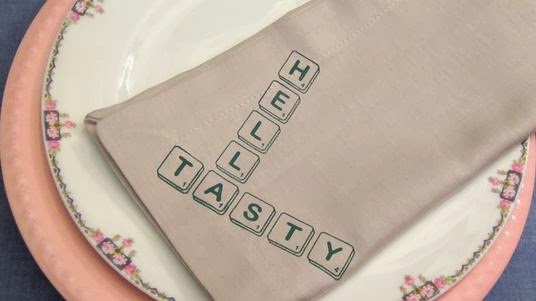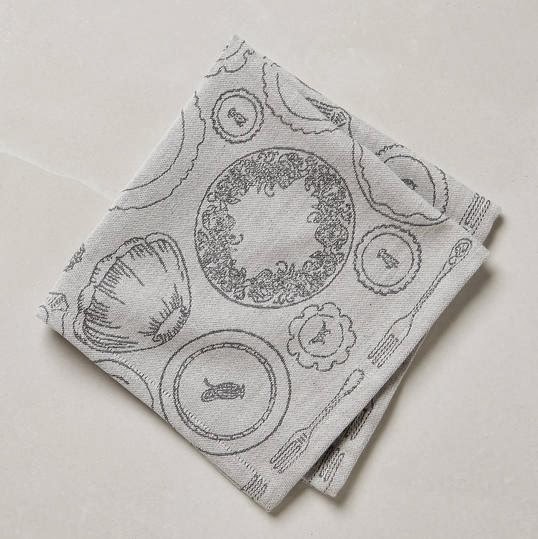It’s time to start prepping for the
biggest meal of the year: Thanksgiving! And to us, the table setting is just as
important as the feast. We showed you ways to dress up your dining table
starting with cute coasters and modern candle holders, and now we’re
moving on to beautiful cloth napkins. Luxe
linen napkins are dotted with topsy-turvy triangles. We love the bright pops of
color against the textured beige fabric. We just found the ultimate modern
linen. A stark white background is an obvious canvas choice for a jumble of
hand-drawn shapes. Give your
table setting an unmistakable fall feel with these denim-colored napkins. Flocks
of screen printed geese add an even more rustic touch. As fans of all things
gilded, we couldn’t pass up these gold-flecked napkins. Their stunning shimmer
is sure to make any table setting feel all the more special. A scalloped
pattern and leafy palm fronds make the most gorgeous, organic-feeling napkin
pattern. Plus, these are perfect to have on hand for any red wine spills!. Are
you sitting at the dinner table thinking “Yo this meal is hella tasty!” Now
your napkin can sing praises of the chef for you! ;) These whimsical napkins
are nothing but cute. We love how bright colors tie these mismatched shapes
together. n’t throw your next dinner party without these celebratory napkins!.
A table setting on a table setting? How meta! Color block napkins?
Count us in! A cool zig zag pattern makes these cheery cotton napkins feel so
inviting. We got a good laugh out of these irreverent napkins that tell your
guests to mind their manners. This set comes with four different etiquette
reminders, including “elbows off the table” and “chew with your mouth closed.”
The napkin is often folded and placed to
the left of the place setting, outside the outermost fork. In an ambitious restaurant setting or a caterer's hall, it may be folded into more or less
elaborate shapes and displayed on the empty plate. Origami techniques can be
used (replacing the traditional paper method with the serviette/napkin) to
create a 3D design e.g. a crane (bird). A napkin may also be held together in a
bundle (with cutlery) by a napkin ring. Alternatively,
paper napkins may be contained with a napkin holder. Napkins were used
in ancient Roman times.
The napkin
ring, occasionally called a serviette
ring, was originally used to identify the napkins of a household between weekly wash days. The standard
napkin ring is a simple ring made from skewers. The figural napkin ring is an
American specialty in which the simple napkin ring is part of a small figure or
sculpture that may take any shape and show any motif. Napkin rings appear as
single items with the name or initials of the owner, notably given as
christening presents, or pairs often given as gifts at weddings and silver
weddings. In the English speaking countries, numbered sets of 4, 6, 8, 10 or 12
napkin rings are found. Napkin rings are an invention of the European
bourgeoisie, first appearing in France
about 1800 and soon spreading to all countries in the western world. Most 19th
century napkin rings were made of silver or silver plate, but others were made
in bone, wood, pearl embroidery, porcelain, glass, and other materials. In the
20th century bakelite and other new materials were used.
Proper Use Of Napkins
Using the napkin at formal occasions, as with much else associated with
etiquette, should be a delicate affair. It is meant only to be dabbed at the
lips and should not get dirty in the process. It might seem that the napkin is
provided precisely so that it can help the diner clean up any mess that might
occur during the course of the meal. Of course, this was its original use,
(once the tablecloth itself ceased to be used as a napkin), and at an informal
occasion such as a barbeque, it still performs this service. The more formal
the event, the more ceremonial the presence of the napkin, because the purpose
of nearly every aspect of table manners is to preserve cleanliness and proper
appearance. If all other elements of the meal are going well, there will be no
danger of smudging the linen.
Starting
As soon as you are seated, remove the napkin from your place setting, unfold
it, and put it in your lap. At some very formal restaurants, the waiter may do
this for the diners, but it is not inappropriate to place your own napkin in
your lap, even when this is the case. If your napkin falls on the floor during
a very formal event, do not retrieve it. You should be able to signal a member
of the serving staff that you need a fresh one.
Finishing
When you leave the table at the end of the meal, place your napkin loosely next
to your plate. It should not be crumpled or twisted, which would reveal
untidiness or nervousness, respectively; nor should it be folded, which might
be seen as an implication that you think your hosts might reuse it without
washing. The napkin must also not be left on the chair. There is a European
superstition that a diner who leaves the napkin on his chair will never sit at
that table again, but other, less supernatural, reasons are often cited for
this, such as, it might seem as if you have an inappropriately dirty napkin to
hide, or even that you are trying to run off with the table linens.











0 comments:
Post a Comment